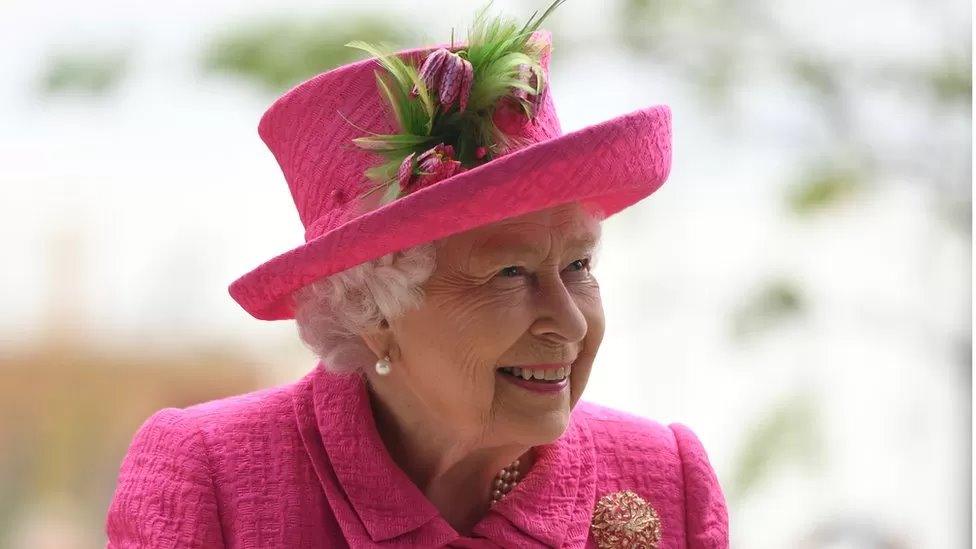Queen Elizabeth and King Charles: A glossary of what all the words mean
- Published
- comments

Queen Elizabeth II, the UK's longest-serving monarch, died at Balmoral aged 96, after reigning for 70 years
The death of Queen Elizabeth II is an historic and important time for the UK.
It will lead to a lot of changes and see a lot of events take place which no-one has seen since the time Queen Elizabeth was crowned, over 70 years ago.
It also means there will be A LOT of words being used that you might not know, and may never have heard before.
So let's try and break some of them down.
Balmoral Castle is hosting the exhibition
Balmoral - Balmoral is one of the UK's royal castles located in Aberdeenshire and was the Queen's home in Scotland. She was said to have loved it there and it was where she spent her final days.
Coronation -The official ceremony where the 'crowning' happens. It's usually a very fancy and important occasion where the country's most important and historic crown is literally put on someone's head.
Cortege - A formal procession, usually a funeral procession. In this case the term is used to refer to the journey the Queen's coffin is making from Balmoral Castle to Edinburgh.
Crowned - To crown someone means to makes a person king or queen.
Elizabeth was crowned at her coronation on 2 June 1953. She stepped into the royal role when she was just 25 years old.
Commonwealth - The Commonwealth is a collection of 54 countries from around the world. In the past many of these nations were part of the British Empire.
Almost one in every three people in the whole world live in the Commonwealth, and it is made up of people of all faiths, races, languages, cultures and traditions.
Heir - An heir is a person who gets your things, title or money when you die. In this case, Queen Elizabeth II's heir - Charles - inherits the throne and becomes King Charles III.
King Charles's heir is his eldest son, Prince William, who would be the future King of the UK.
Queen Elizabeth II and her son, and the now King, Charles III
Head of state: The chief public representative of a country, such as a president or monarch, who may also be the head of government. In the UK it's the king or queen but in the USA or Ireland, it's the president.
Monarch - Monarch is the name given to a person who is the head of a nation such as a king or a queen. In the UK system there always needs to be a monarch so when Queen Elizabeth II died, the title passed immediately to her eldest son, who became Charles III.
Prince of Wales - The current Prince of Wales is Prince William. As King Charles' eldest son the title is passed to William from his father.
Camilla, the wife of King Charles III, will be known as the Queen Consort
Queen Consort - The wife of a King isn't always a Queen. So this title can be given to the wife of a reigning King to give them an official status. In this case it has been given to Camilla, as Queen Elizabeth II wished.
Reigning - A reign means the period of time a person spends as king or queen. Queen Elizabeth II had the longest reign of any UK ruler and one of the longest reigns of any monarch in history.
Throne - To be on the throne means reigning as the monarch or ruler of a country.
Address to the nation: This is where a country's leader or ruler speaks directly to the public - usually at an important time or event. It is often live on TV and online, but can also be recorded in advance.
The most recent state funeral in the United Kingdom was in January 1965 for Prime Minister Sir Winston Churchill, who led the country during World War II.
State funeral - A funeral is the occasion when people remember and pay tribute to a loved one who has died. A state funeral is a huge public memorial ceremony for an important person, to whom the whole country is paying tribute.
It is very strictly organised and includes many important and historical ceremonial elements as well as often having military parades and a religious service. In the UK, state funerals are usually reserved for monarchs - such as Queen Elizabeth II - with rare exceptions.
Hundreds of thousands of people queued for hours to see the coffin of the Queen Mother when she died in 2002.
A state funeral is often preceded by the person being honoured "lying in state" which is when the person's coffin is put in one or more significant places, so that the public can go in person to pay their respects.
Lying-in-state - The placing of a coffin on view to allow the public to pay their respects to the deceased before the funeral ceremony takes place. In the UK this usually tradition for the Sovereign (king or queen) and sometimes former Prime Ministers.
Tributes - Expressions of respect paid to a person who has recently died.
Vigil - Keeping watch for a period of time. The Queen's four children have been carrying out the traditional Vigil of the Princes at their mother's coffin in St Giles' Cathedral, Edinburgh. Each standing near and keeping watch.
